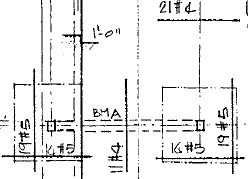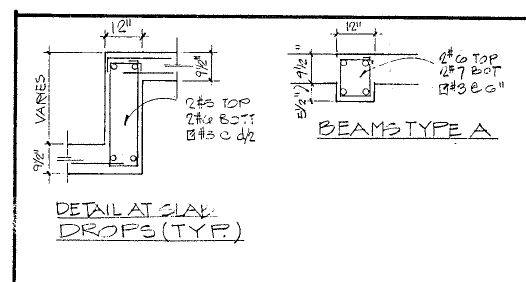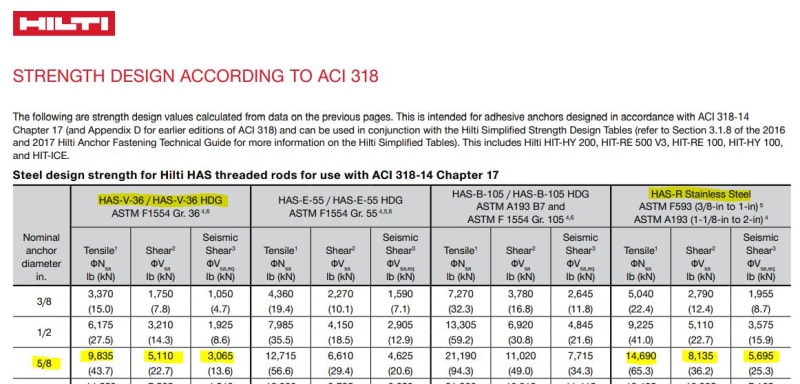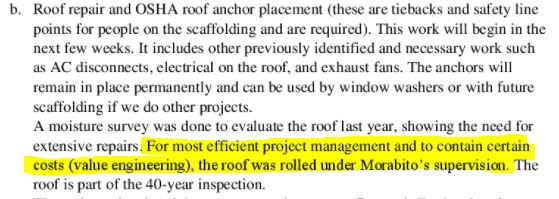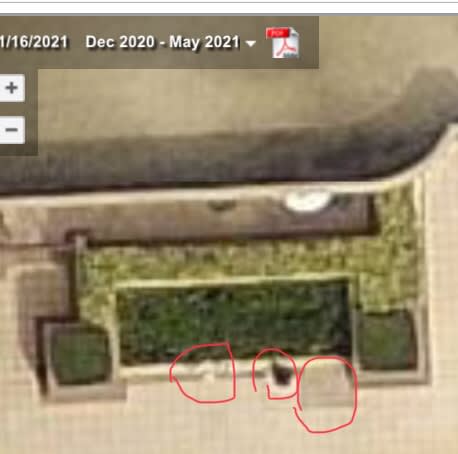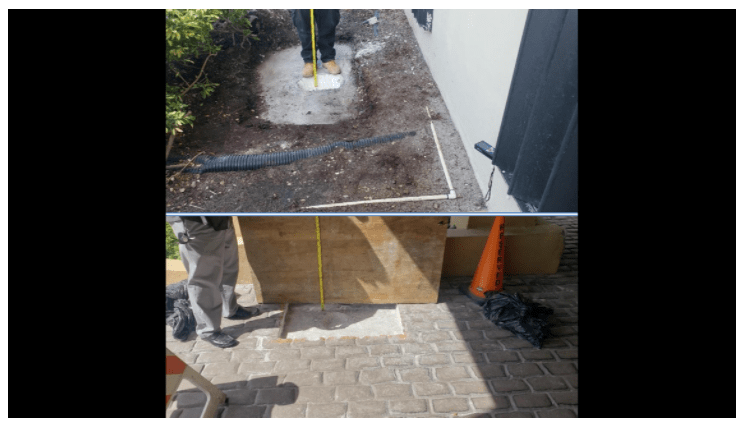Yes, we all agree the structural plans are a mess, but I think the roof anchor plans are a mess too. This work was occurring the day of the collapse. So I continue to start there as the initial cause. Remember the Kansas City collapse was down to a simple bolt detail.
The reading of this note appears incorrect:
The 5,000 lbs. testing number doesn't make sense with the Hilti adhesive anchors.
HAS-V-36 et all is carbon steel and HAS-R is stainless steel and both have very different capacities at 5/8" dia.
Stainless steel should have been used due to being near the water but "carbon steel" was specifically stated in the note on the plans.
And, neither of them divide to any reasonable multiple of 5,000 lbs. for testing, but the OSHA rule does for the entire assembly including 4 x adhesive anchors do see below.
The OSHA Rope Descent System (RDS) Anchorage (not a fastener) needs to withstand 5,000 lbs. ultimate load in any direction.
In Florida rope decent systems are allowed in buildings less than 300 feet and above 300 feet if it is the only feasible method of access.
Rope Descent System (RDS) Anchorages must be tested before first use and at regular intervals.
IWCA/ANSI I-14.1-2001 Section 8.1.3 requires testing of twice the 1,250 lbs. design load in each primary direction or 2,500 lbs.
OSHA 2019 Testing Interpretation
January 25, 2019
Mr. Reg Ranahan
GSS Corporation
80 Hudson Road, Ste. 100
Canton, Massachusetts 02021
Dear Mr. Ranahan:
Thank you for your letter to the Occupational Safety and Health Administration (OSHA)[. Your letter has been referred to the Directorate of Enforcement Programs for an answer to your specific question] regarding 29 CFR 1910.27(b)(1)(i). [This letter constitutes OSHA's interpretation only of the requirements herein, and may not be applicable to any question not delineated within your original correspondence.] Your letter requests clarification of the requirements for rope descent system anchorages under 29 CFR 1910.27(b)(1)(i). Your paraphrased question and OSHA's response are below.
Question: International Window Cleaning Association/American National Standards Institute (IWCA/ANSI) I-14.1-2001 Section 8.1.3 requires that anchorages "be tested by applying a minimum static load of twice the design load in each (primary) direction that a load may be applied. For example, an anchorage with an ultimate capacity of 5000 pounds (2268 kg) has a four to one safety factor. Therefore the anchor's design load is 1,250 pounds (567 kg) and it shall be tested at 2500 pounds (1134 kg)." Under 29 CFR 1910.27(b)(1)(i), must anchorages be tested at 5,000 pounds, or is it permissible to test them at 2,500 pounds, as described in IWCA/ANSI I-14.1-2001?
Response: 29 CFR 1910.27(b)(1)(i) requires that building owners inform employers, in writing, that the building owner has identified, tested, certified, and maintained each anchorage so that it is capable of supporting at least 5,000 pounds, in any direction, for each worker attached. Certification of each anchorage must be performed by a qualified person. Because the OSHA standard does not specify criteria for testing anchorages, the qualified person may utilize any scientifically-valid testing criteria to determine whether an anchorage is capable of supporting at least 5,000 pounds (2,268 kg) per attached worker. In general, this means using criteria that would be accepted by an industry consensus group, or that are certified by a registered professional engineer. OSHA would consider the testing criteria described in your letter – wherein an anchorage with a 5,000-pound ultimate capacity/strength and a four to one safety factor with a design load of 1,250 pounds is tested at 2,500 pounds – to be acceptable under 29 CFR 1910.27(b)(1)(i).
Thank you for your interest in occupational safety and health. We hope you find this information helpful. OSHA's requirements are set by statute, standards, and regulations. Our letters of interpretation do not create new or additional requirements but rather explain these requirements and how they apply to particular circumstances. This letter constitutes OSHA's interpretation of the requirements discussed. From time to time, letters are affected when the Agency updates a standard, a legal decision impacts a standard, or changes in technology affect the interpretation. To assure that you are using the correct information and guidance, please consult OSHA's website at
If you have further questions, please feel free to contact the Directorate of Enforcement Programs at (202) 693-2100.
Sincerely,
Patrick J. Kapust, Acting Director
Directorate of Enforcement Programs
[Corrected 4/17/2019]
My hypothesis continues to be:
The roof anchors were installed on the cantilevered sections of the roof (not per the plans, this is evidenced by actual installation on the remaining portion of the building.)
Then the fall protection anchors (either the entire assembly or only the adhesive anchor fasteners) were tested at much too high of a force (note on plans is unclear.)
This improper placement and testing then damaged the concrete roof slab above the penthouse over the x11 unit.
This concrete slowly failed through the evening, completely failing that night around 1 am causing the cantilevered portion and parapet to crash onto the pool deck and into the backside of column I/12.1
I/12.1 is the column with the unverified report of a possibly missing beam, and the column with impact damage to the backside according to the ENR report I posted a link to in a previous post.
I/12.1 shifted due to the impact that caused the guest parking and pool deck to fail.
The pool deck failed due to additional load and column damage causing the columns under x11 stack to fail.
Another note:
Morabito is the structural engineer and someone with that name works for the roof anchorage contractor - they are located within 20 miles of each other near Baltimore, MD and they both also have offices in South Florida.
I'm pretty sure they have a relationship.
The roof anchorage contractor appears to have been doing unpermitted work, they pulled their permit the day of the collapse.
With that said, I don't think we should rely on Morabito's statements at the current time.
I believe it's likely Morabito emailed the report to the city (they received it after the collapse) in an attempt to divert attention and cover up a roof anchorage mistake.
From a recent HOA letter:

